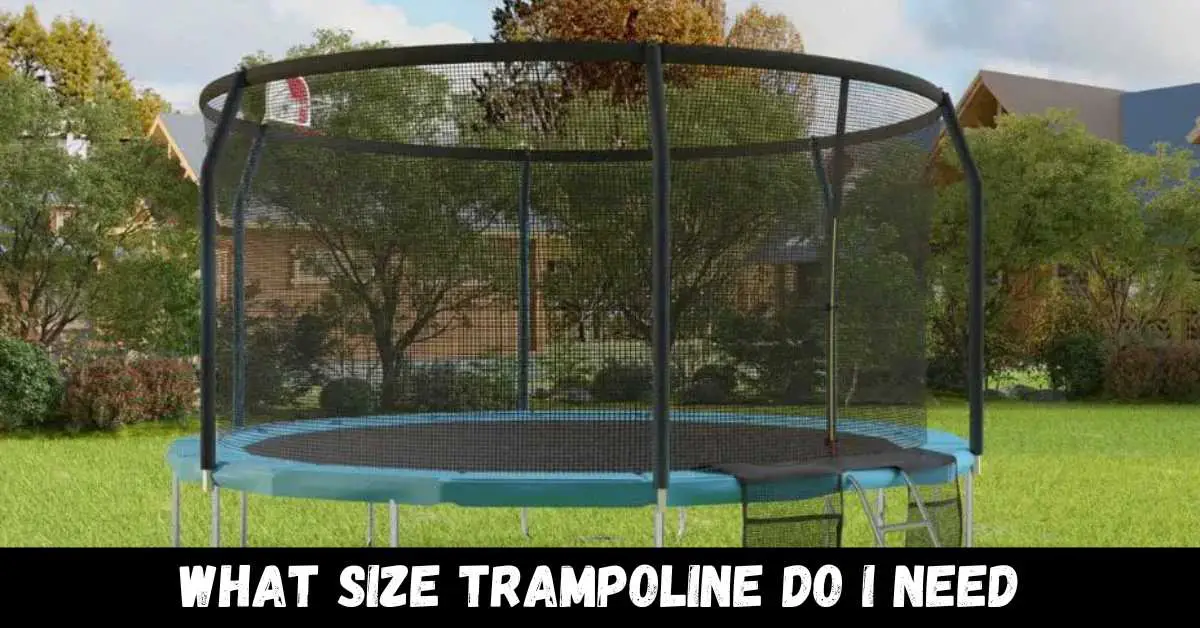We understand the importance of owning the perfect-size trampoline. Not only does it maximize the bouncing fun and entertainment, but it also ensures safety and prevents severe injuries.
When it’s time to choose the best-size trampoline, we often find ourselves in a dilemma due to the abundance of options and the complexity of diverse trampoline shapes and types.
That’s why we have created a trampoline size guide to ease your worries and help you pick the right one from the different trampoline sizes available.
Our comprehensive trampoline size chart will provide you with all the information you need to make an informed decision.
So, keep reading, and let us guide you in selecting the perfect trampoline that meets your needs and preferences. We want you to enjoy every moment of bouncing fun while ensuring safety for you and your family.
In this article, we will discuss what size trampoline I need.
What Size Trampoline Do I Need: 12 ft trampoline – Suitable for all ages, requires 3.7m of space, accommodates 2 adults or 3 kids. 14 ft trampoline – Ideal for large lawns, requires 4.2m of space, fits 3 adults or 4 kids.
What is the method for measuring a trampoline?
To measure the size of a trampoline, simply measure the frame from one side to the other (the diameter). Use a tape measure to measure across the center of the trampoline, and repeat the measurement in different directions to ensure accuracy.
Keep in mind that the trampoline size includes both the jumping surface and the springs/safety mats.
What amount of space is required for a trampoline?
According to Springfree, a popular trampoline brand, it is recommended to have a clearance space of 1.5 meters on all sides of the trampoline. For example, for a round 10-foot trampoline, you would need a space that is 6 meters long and 6 meters wide.
It’s important to place the trampoline away from any obstacles, such as buildings or fences, to prevent potential injuries.
What are the typical dimensions of a standard trampoline?
Trampolines that are 10ft in size are considered small/medium, while 12ft trampolines are considered medium/large. These sizes are popular among families as they don’t take up too much space in the backyard but still provide ample bouncing fun.
How do you determine the right size of trampoline to purchase?
There are no strict rules when it comes to trampoline sizes and ages. If your kids want to learn tricks or have multiple jumpers at the same time, a larger trampoline like 12ft or 14ft may be beneficial. However, bigger trampolines can be more expensive and take up more space.
According to trampoline brands like Vuly and JumpFlex, 10ft trampolines are ideal for smaller yards, while 12ft trampolines are the most popular size suitable for all ages. 14ft trampolines are great for larger lawns and provide space to learn tricks.
It’s important to consider the space required and the number of users when choosing the right trampoline size for your needs.
What are the differences between springless and spring trampolines?
It’s worth noting that on springless trampolines, the jumping surface is usually larger compared to traditional trampolines. This is because the springs and frame are located underneath the jumping mat, providing more space for bouncing and jumping.
Unlike regular trampolines that use springs, springless trampolines utilize heavy-duty elastic straps, flexible composite rods, or leaf springs.
This design eliminates the risk of children getting their hands caught in the springs or landing on them, making springless trampolines generally considered safer for use.
What weight limits should be considered when using a trampoline?
It’s crucial to check the maximum weight limit specified by the manufacturer when buying a trampoline. This information is usually provided and can range from 100kg to 250kg. Smaller trampolines generally have lower weight limits compared to larger ones.
Consider how many people will be using the trampoline at once and how long you plan to use it, especially if adults will also be jumping on it. This will help ensure that the trampoline is used safely and reliably for years to come.
Which shape is better: round or rectangular trampolines?
When it comes to trampolines, there are two main shapes to choose from round and rectangular. Round trampolines are the most popular because they are often more affordable and designed to direct the jumper back toward the center of the trampoline.
This can help keep the jumper within a safe bouncing area and reduce the risk of bouncing off the trampoline surface.
Round trampolines are commonly seen as safer because they are designed to keep the jumper in the center of the trampoline while bouncing. However, this can sometimes lead to collisions between multiple jumpers who may inadvertently bump into each other while bouncing.
On the other hand, rectangular trampolines provide a higher bounce as they have multiple sweet spots on the surface area that can result in a more vigorous and dynamic bouncing experience.
Recommended Trampoline Sizes Based on Age Groups
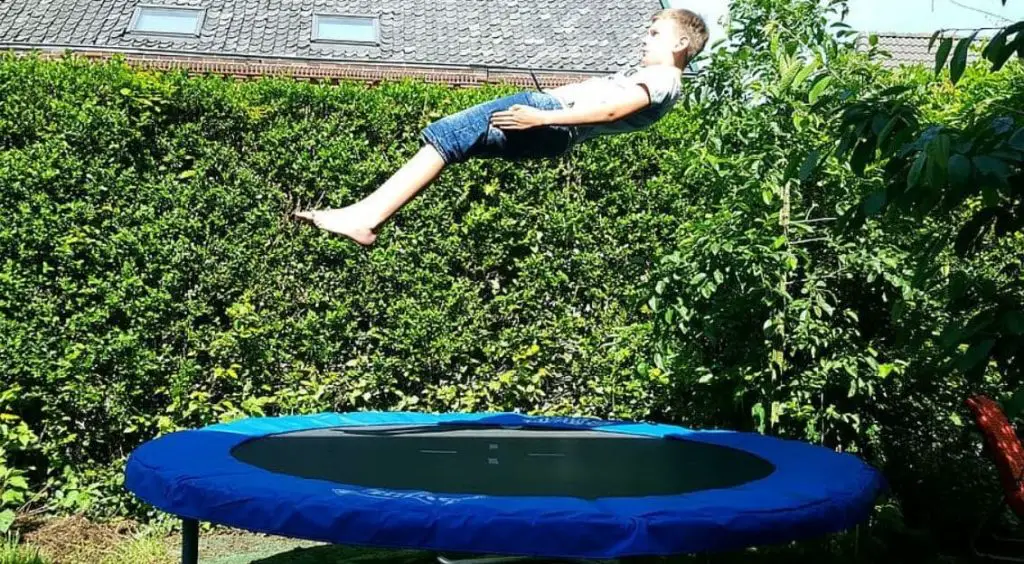
If you’re wondering what size of trampoline is suitable for both adults and kids, it’s important to consider the age of the kids. As kids grow older, larger trampolines are usually recommended.
For toddlers aged 1 to 3 years old, mini trampolines or toddler-sized trampolines are ideal as they are designed to provide gentle bouncing that won’t cause any harm. For kids aged 4 years and above, mini trampolines or trampolines ranging from 4.5 to 6 feet in size are generally suitable.
For kids who are 5 to 6 years old, trampolines ranging from 6 to 10 feet in size are suitable. For kids aged 7 to 9 years, trampolines ranging from 8 to 12 feet are recommended. For 10-year-olds, trampolines ranging from 12 to 14 feet are ideal.
For kids aged 11 to 13 years, it’s important to choose a trampoline that is at least 12 feet in size and not exceed 16 feet. For teenagers aged 14 to 16 years, trampolines larger than 14 feet are recommended.
For adults who are into gymnastics, Olympic trampolines are suitable. For fitness enthusiasts, including during pregnancy, rebounders’ workouts are good options, but it’s important to be aware of any potential negative side effects of using a rebound.
It’s always important to prioritize safety and follow the manufacturer’s recommendations when choosing the right size trampoline for different age groups.
Measuring Octagonal Trampolines: Step-by-Step Guide
Here are notes some points for how to measure octagonal-sized trampolines;
- Measure from one corner to the exact opposite corner diagonally for the diagonal measurement of the octagonal trampoline.
- Repeat the measuring process in perpendicular directions, measuring from one side to the opposite side, for length and width measurements.
- Calculate the average of both readings by adding them together and dividing by 2 to determine the overall size of the trampoline.
- This method ensures accurate measurement for selecting the appropriate size of the octagonal trampoline.
Types of Trampoline Sizes
When selecting an outdoor trampoline, it’s important to consider the size that best fits your needs. Trampolines come in various sizes, ranging from small to large.
Let’s take a look at the different options available, starting from the smallest and going up to the largest-size trampolines.
A Small Trampoline:
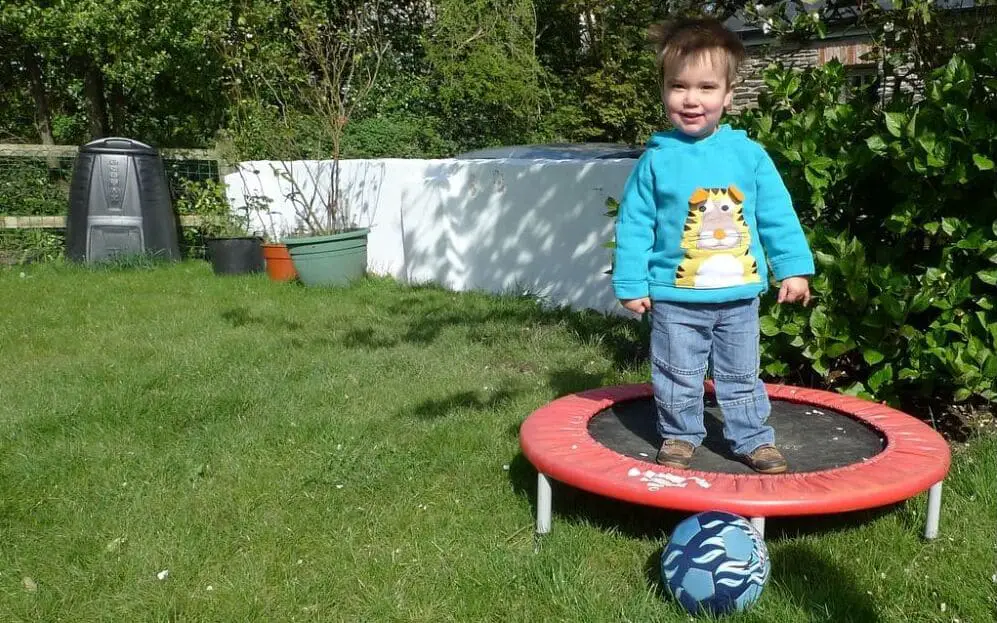
6 ft Trampolines: These trampolines are perfect for smaller backyards that have limited space. They are commonly used for children aged 6-8 years, as they provide a safe and enjoyable bouncing experience for kids in this age range.
The smaller size allows for easy installation in tight spaces, making them a popular choice for smaller outdoor areas.
8 ft Trampolines: Slightly larger than 6 ft trampolines, 8 ft trampolines are suitable for smaller yards and provide more bouncing areas for kids to enjoy.
They are designed for children aged 6-10 years, making them a great option for slightly older kids who may need a bit more space to bounce and play.
Despite being slightly larger than 6 ft trampolines, they can still fit comfortably in smaller yards, making them a popular choice for families with limited outdoor space.
A Medium Trampoline:
10 ft Trampolines: As the first medium-sized trampoline size, 10 ft trampolines are suitable for mid-sized yards. They are versatile and can accommodate both kids and adults, making them a popular choice for families with varying age groups.
With a larger bouncing area compared to smaller trampolines, 10-foot trampolines provide ample space for enjoyable bouncing and play.
12 ft Trampolines: 12 ft trampolines are one of the most commonly purchased trampoline sizes, and they are typically used in mid-sized to larger backyards. They offer a larger bouncing area than smaller trampolines, providing more space for bouncing and playing.
They are a popular choice for families with bigger yards or more space to accommodate a larger trampoline.
A Large Trampoline:
14 ft Trampolines: With a larger size, 14 ft trampolines are commonly used in larger backyards that have ample space for jumping. They are suitable for jumpers of all ages, from kids to adults, making them versatile for family use.
These trampolines provide a spacious bouncing area for a fun jumping experience.
16 ft Trampolines: The largest common outdoor trampoline size, 16 ft trampolines are designed for big backyards or families that want plenty of jumping space.
These trampolines offer a generous bouncing area, allowing for multiple jumpers to play and bounce together. They are ideal for families with ample yard space and a desire for a more expansive trampoline experience.
Choosing the Perfect Trampoline Size: Essential Steps to Consider
After familiarizing yourself with the various sizes available for outdoor trampolines, it’s time to delve into the essential steps for selecting the perfect size that suits your backyard.
Consider the Users of the Trampoline: Who Will be Jumping?
The next important step in choosing the right trampoline size is to consider who will be using it regularly. You need to check the single jumper weight capacity, which is the maximum weight a trampoline can safely handle for a single jumper without bottoming out.
This is calculated based on the expected height the jumper will reach and its weight. For example, if a trampoline has a weight capacity of 220 pounds, it means that a person weighing up to 220 pounds can jump on it without the risk of falling through.
However, if you weigh more than the weight capacity, there is a higher risk of bottoming out when reaching maximum height, although you can still jump on the trampoline.
To determine the right trampoline size, you need to calculate the total weight of all potential jumpers and find a trampoline with a weight capacity that can safely accommodate that weight.
You can usually find weight capacities on the manufacturer’s website or by contacting the company directly. If you’re buying a trampoline for a child, consider their potential growth as they get older.
Buying a smaller trampoline may result in them outgrowing it quickly, so it’s better to invest in a larger trampoline if you have the space, to ensure it can be used for a longer time.
Think of trampolines like clothes, it’s better to buy something that your child can grow into rather than out of within a short period.
Assess Your Yard:
The initial and crucial step in determining the right trampoline size is measuring the size of your yard. It’s essential to take this step seriously, so let’s go over how to accurately measure your yard for a trampoline:
What are the Steps to Measure for a Trampoline?
Here are some steps to Measure for a Trampoline:
Step 1: Choose a flat and even spot in your yard for the trampoline, avoiding areas with debris, branches, or slopes steeper than three degrees.
Step 2: Use a measuring tape to measure the length and width of the chosen area.
Step 3: Add 3-5 feet to all sides of the measured area to ensure safe lateral clearance space for the trampoline. This is important to keep obstacles like fences, sheds, or trees at a safe distance.
By following these steps, you can accurately measure your yard and determine the appropriate size of trampoline that will fit safely in your chosen location.
When measuring your yard for a trampoline, it’s important to keep in mind the following points:
Consider the design of the trampoline:
Different trampolines have different requirements for clearance space. Traditional trampolines with static metal poles and a non-flexible net may need less clearance space compared to trampolines with a flexible net and enclosure rolls, such as a Springfree Trampoline.
Take into account the design of the trampoline when measuring the yard.
Check the manufacturer’s recommendations:
Each trampoline manufacturer may have specific recommendations for the amount of clearance space needed. It’s important to check with the manufacturer to determine the additional space you should accommodate when measuring for the trampoline.
Following the manufacturer’s recommendations can help ensure safe usage of the trampoline.
Consider the intended use:
The amount of clearance space needed may also depend on who will be using the trampoline. If your child is an aspiring gymnast who consistently practices flips and tricks on the trampoline, you may need to provide more room compared to a child who uses the trampoline for playing basketball or general jumping.
Consider the intended use of the trampoline and allocate sufficient space accordingly.
Balance comfort with safety:
Ultimately, it’s your decision on how much space you want to allocate for the trampoline in your yard. However, it’s important to remember that inadequate clearance space can increase the risk of injuries.
It’s recommended to prioritize safety and follow the manufacturer’s recommendations to ensure safe usage of the trampoline.
Consider trampoline shape:
Trampolines come in various shapes, including round, square, rectangle, and oval. Consider the shape of the trampoline that fits best in your backyard and ensure that you have enough space to accommodate the chosen shape.
By considering the design of the trampoline, following the manufacturer’s recommendations, considering the intended use, balancing comfort with safety, and considering the trampoline shape, you can accurately measure your yard and determine the appropriate size and placement of the trampoline for a safe and enjoyable jumping experience.
What is the typical price range for a trampoline?
There are trampolines available at various price points. Cheaper trampolines can be found in the $100-$400 range, but they may have fewer safety features or be made with less premium materials.
On the other hand, high-end trampolines can cost $1500 or more and may feature advanced technologies such as flexible composite fiberglass rods or next-generation leaf springs, like the Springfree trampolines or the Vuly Thunder Pro.
What Size Trampoline Do I Need: Factors to Consider
Factors to Consider When Determining the Size of Trampoline You Need:
Yard Space:
Here we discuss the yard space:
Measure available space to determine trampoline size:
Start by measuring the area in your yard where you plan to place the trampoline. Consider the length, width, and any obstacles such as trees, fences, or sheds that may require clearance space.
It’s important to choose a trampoline size that fits comfortably within the available space, leaving enough room for safe use and movement around the trampoline.
Consider safety clearance around the trampoline:
In addition to the dimensions of the trampoline itself, it’s crucial to factor in the safety clearance around the trampoline. Most trampoline manufacturers recommend leaving a clear space of at least 3-5 feet around the trampoline to prevent accidents and injuries.
This clearance space should be free of any obstacles or hazards, such as trees, walls, or other structures.
User Age and Skill Level:
Here we discuss user age and skill level:
Younger children may need smaller trampolines:
If the trampoline will primarily be used by younger children, it may be appropriate to choose a smaller trampoline size. Smaller trampolines typically have lower bounce heights and are better suited for younger kids who are just starting to learn how to use a trampoline safely.
Consider the age, size, and skill level of the youngest users when determining the appropriate trampoline size.
Older children and adults may require larger trampolines:
Older children, teenagers, and adults may require a larger trampoline size to accommodate their size, weight, and skill level.
Larger trampolines generally have higher bounce heights and larger jumping surfaces, which can provide a more enjoyable experience for older users who may want to perform tricks, and flips, or engage in more vigorous exercise routines on the trampoline.
Usage:
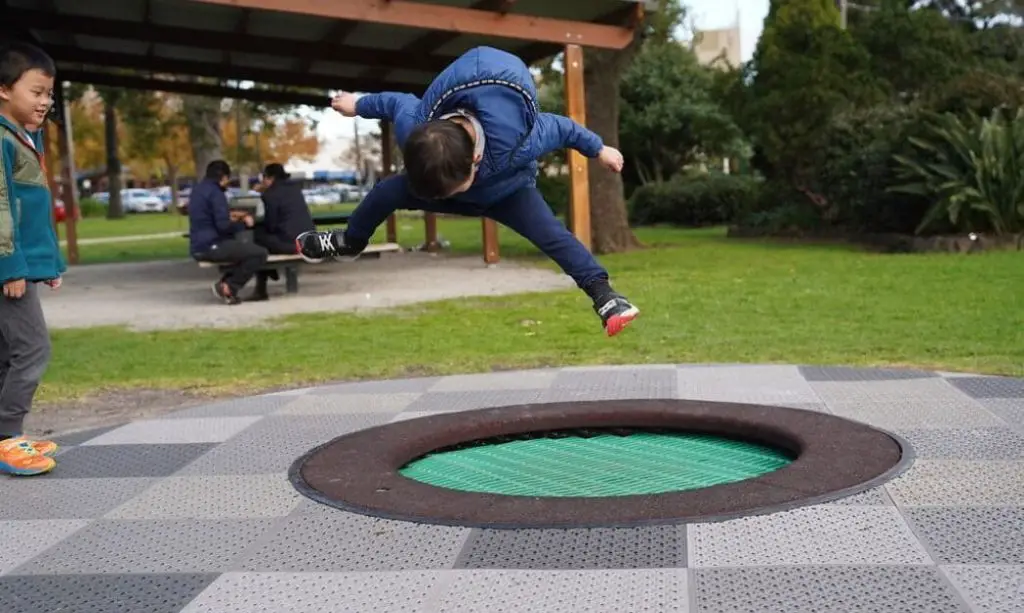
Here are we discussing usage
Consider if the trampoline will be used for recreational bouncing, tricks, or exercise:
Think about the primary purpose of the trampoline in terms of its usage. If it will mainly be used for recreational bouncing, a smaller trampoline may be sufficient.
However, if you plan to use the trampoline for tricks, advanced maneuvers, or exercise purposes, a larger trampoline with a higher weight capacity and larger jumping surface may be more suitable.
Determine if one or multiple users will be on the trampoline at the same time:
Consider how many users will be on the trampoline at the same time. If you anticipate multiple users, such as siblings or friends, using the trampoline simultaneously, you may need a larger trampoline to provide enough space for safe jumping without overcrowding.
It’s important to choose a trampoline size that can comfortably accommodate the anticipated number of users to ensure a safe and enjoyable bouncing experience for everyone.
By considering factors such as yard space, user age and skill level, and intended usage, you can determine the appropriate trampoline size that meets your specific needs and requirements.
Taking the time to carefully evaluate these factors will help ensure that you choose a trampoline size that provides a safe and enjoyable jumping experience for all users.
Safety Considerations
Safety is a crucial factor to consider when using a trampoline. Here are some important safety considerations to keep in mind:
Enclosure and Safety Net:
Choose a trampoline with a safety enclosure or net that surrounds the entire jumping area. This helps prevent users from falling off the trampoline and reduces the risk of injuries.
Frame and Springs:
Ensure that the trampoline’s frame and springs are in good condition and properly installed. Regularly inspect for any signs of wear, rust, or damage, and promptly address any issues to prevent accidents.
Weight Limit:
Follow the manufacturer’s recommended weight limit for the trampoline. Overloading the trampoline with too many users or exceeding the weight limit can increase the risk of injuries.
Proper Use:
Educate all users on proper trampoline safety guidelines, including no somersaults, flips, or dangerous maneuvers unless supervised by a trained professional. Users should also avoid bouncing off the trampoline onto other surfaces or objects.
Supervision:
Ensure that the trampoline is used under proper supervision, especially for younger children. Adult supervision can help prevent accidents and injuries.
Placement and Clearance:
Place the trampoline on a flat, level surface away from any obstacles such as trees, walls, or structures. Follow the manufacturer’s recommended safety clearance guidelines, leaving enough space around the trampoline to prevent collisions or accidents.
Weather Conditions:
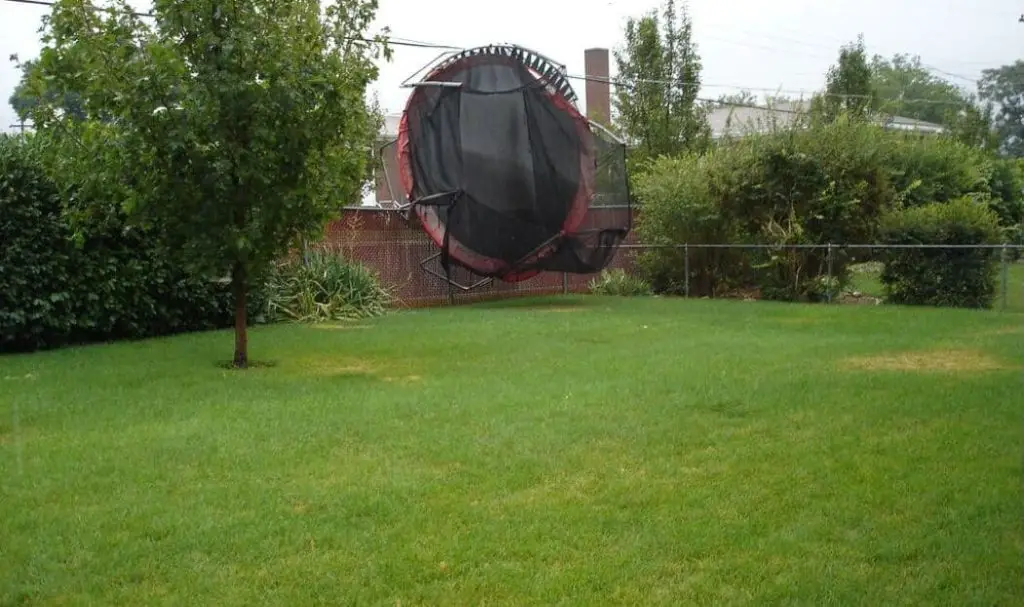
Avoid using the trampoline during inclement weather, such as high winds, rain, or snow, as it can increase the risk of accidents and injuries.
Maintenance:
Regularly inspect and maintain the trampoline, including the frame, springs, safety net, and padding. Replace any worn-out or damaged parts promptly to ensure optimal safety.
Personal Protective Equipment:
Encourage users to wear appropriate footwear, such as non-slip socks or athletic shoes, and avoid wearing jewelry or loose clothing that can pose a safety hazard.
Age and Skill Level:
Consider the age and skill level of the users when determining appropriate trampoline activities. Younger children or inexperienced users may require additional supervision and guidance to prevent accidents.
By prioritizing safety and following these important considerations, you can minimize the risk of accidents and injuries while enjoying the fun and benefits of trampoline use. Always prioritize safety and adhere to the manufacturer’s guidelines for safe trampoline usage.
FAQs:
Q:1 Can a 12ft trampoline accommodate 3 kids comfortably?
A 12-foot trampoline is suitable for two kids to jump and do flips comfortably. However, if you add more than one adult, it may start to feel crowded and reach its weight limit. For heavier adults, a 14-foot trampoline may be a better option as it provides more space and weight capacity.
Q:2 Is a 12ft trampoline spacious enough for multiple users?
A 12-foot trampoline is a good fit for a family with two kids. However, if you have more active kids or want to accommodate more children jumping at the same time, a 14-foot trampoline may be a better choice.
A larger trampoline provides more space for jumping and tumbling, allowing for more fun and excitement for kids.
Q:3 How many people can a 14ft trampoline accommodate?
A 14-foot trampoline can fit around 5 to 6 kids or 2 adults all at once. If you want even more space to jump, you can choose a 15-foot trampoline. This way, your kids can have their friends over to jump with them, or you can join in on the fun too!
Q:4 Is a 10ft trampoline suitable for 3 kids to use together?
If you have a young family or a small yard, a 10-foot trampoline would be a great fit, but it can only hold up to 150 kilograms of weight. It’s better suited for bigger children or adults who want to jump on it.
Q:5 Can adults comfortably use a 10ft trampoline?
How much weight can a 10-foot trampoline hold? It can support adults who weigh up to 100 kilograms (approximately 16 stone), but it’s not safe for multiple children to bounce on it at the same time.
To ensure safety, we recommend that only one person bounces on the 10-foot trampoline at any given time.
Q:6 What are the differences between a 10ft and 12ft trampoline?
If you have more than one child or a larger child, a 12-foot trampoline is a better option compared to a 10-foot trampoline. The 12-foot trampoline is wider and bigger, and it has a higher enclosure net, which makes it safer for your children to jump on.
It offers more space and a more secure net, making it a suitable choice for families with multiple children or larger kids.
Q:7 What is the weight capacity of a 12ft trampoline?
Round trampolines usually have a weight limit of around 100 kilograms (approximately 15 stone 7 pounds) due to the structure and materials used.
This means that even if you choose a larger trampoline, such as a 12-foot or 14-foot trampoline, the weight limit will still be capped at 100 kilograms.
Conclusion:
In conclusion, choosing the right size trampoline for your needs requires careful consideration of various factors. Firstly, the available space in your yard or designated area should be taken into account, ensuring that the trampoline fits comfortably without posing any safety hazards.
Secondly, the age and size of the users should be considered, as smaller trampolines may be appropriate for young children while larger trampolines may be preferred for older kids or adults.
Additionally, the weight capacity of the trampoline is a crucial factor to consider, as exceeding the weight limit can pose safety risks. It’s important to carefully review the specifications provided by the manufacturer and select a trampoline that can safely accommodate the intended users’ weight.
By taking into account these factors and adhering to the manufacturer’s recommendations, you can ensure a safe and enjoyable jumping experience for yourself and your family.
Remember, safety should always be the top priority when choosing the size of trampoline that best fits your needs.
We hope you will be well aware of what size trampoline do I need. After reading this comprehensive article. If you have any questions, Don’t hesitate to feel free to comment below!

